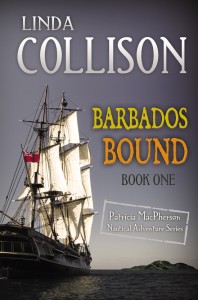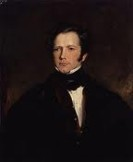As I prepare to take part in the Ships Ahoy! The joys and challenges of writing Nautical Historical Fiction session at the Historical Novel Conference in London, less than three weeks away, I’ve been gathering my thoughts on the history of Salty Old Fiction.
While stories with a maritime flavor are as old as Homer’s Odessy, historical nautical fiction as a genre, is generally thought to have begun with the novels of the English naval captain, Frederick Marryat (1792—1848) whose semi-autobiographical novel, Mr. Midshipman Easy, was published in 1836, with many others to follow, such as The Three Cutters, The Phantom Ship, Privateersman, etc.
Yet Marryat was not the first man to fictionalize his own naval experiences. A century earlier, Tobias Smollet (1721-1771) had written his Adventures of Roderick Random, a picaresque novel about a surgeon’s mate, based on Smollet’s real-life experiences during the Battle of Cartagena in 1741. Both men employ humor and parody in their fictionalized accounts of life in the British Navy.
It wasn’t until the early 20th century that the genre hit the limelight with the publication of a series of books by C.S. Forester – the pen name of Englishman Cecil Lewis Troughton Smith. These books followed the career of Horatio Hornblower, a naval officer during the Napoleonic Wars, and they became a sort of blueprint for novelists to come. Novelists such as Dudley Pope, Douglas Reeman, a.k.a. Alexander Kent, and Patrick O’Brian, whose Aubrey/Maturin series, set the bar high.
What all of these men and the dozens more who followed in their footsteps have in common is they wrote about the Napoleonic wars from the perspective of a British naval officer – or from the other side of the Pond, as an officer in the fledgling United States Navy. Some of these contemporary authors include Michael Aye, Alaric Bond, Broos Campbell, David Donache, William C. Hammond, Dewey Lambdin, James Nelson, Julian Stockwin, and Victor Suthren. What these guys have in common is they all write about war at sea during the 18th and 19th centuries, employing either British or American protagonists in a connected series. These novelists enjoy a loyal following of saavy readers.
A broader view of historical nautical fiction includes classic literary stand-alone novels. Favorites of mine include Daniel DeFoe’s Robinson Crusoe, the novels of Joseph Conrad, James Fennimore Cooper’s Wing and Wing, Herman Melville’s White Jacket, Typee, and of course, Moby Dick; Richard Henry Dana’s autobiographical account, Two Years Before the Mast, Edgar Allen Poe’s only novel, The Narrative of Arthur Gordon Pym, Jack London’s Sea Wolf, and others. More recent historical nautical fiction might include Jim Crace’s Signals of Distress, Miranda Hearn’s Nelson’s Daughter, Iris Murdoch’s The Sea, The Sea, the literary novels of Barry Unsworth, including Sacred Hunger and Losing Nelson.
Nor is the genre entirely the province of English-speaking authors. The father of the French maritime novel, Edouard Corbiere, lived from 1793 to 1875 and wrote fiction based on his own experiences. ( I’ve just purchased Oeuvres de Edouard Corbiere on my Kindle and I’m looking forward to reading his work.) Emilio Salgari was an Italian author of swashbuckling sea stories such as The Black Corsair. Ferenc Mate is a contemporary Hungarian-born author who writes sea-faring novels in English.
I have only scratched the surface, mentioning the heart of the genre, which is chiefly concerned with men on ships doing battle. And that begs the question, what is nautical historical fiction? I’ll define it broadly as historical fiction in which the sea plays an important role as setting and is important to the characters or provides conflict. Under that definition, the genre is quite large and as protean as the sea itself. Literary novels, adventure novels, romance novels, fantasy, alternative history, coming-of-age, gothic novels – all could take place on a ship or in a seaport, in a bygone era.
As nautical author Rick Spillman said, nautical historical fiction is no longer just a bunch of old white men writing about Nelson. Rick’s own first novel, Hell Around the Horn, is a realistic account of a merchant windjammmer’s journey from Cardiff to Chile, around Cape Horn, during the last days of sail. Women are breaking into the field, myself included. When my publisher, the late Tom Grundner of Fireship Press, said “stick with me and I’ll make you the premier female author of historical nautical fiction”, I laughed. Two years ago, I thought that I was the only female writing historical nautical fiction. (Well, except for Joan Druett, who is perhaps better known for her non-fiction nautical books, such as the award-winning Tupaia, Island of the Lost, In the Wake of Madness, Hen Frigates, Rough Medicine, She Captains, etc.) Then I discovered Margaret Muir – an Englishwoman transplanted to Tasmania, the author of five historical novels, including Floating Gold, set at sea in the 19th century. Margaret and I have become friends through correspondence. Very recently (since Tom Grundner’s death last year) Fireship Press has published new nautical historical fiction by Susan Keogh, Barbara Peacock, and V.E. Ulett (also a woman). I am not alone, it seems, but in very good company. 
It’s not a win-lose game; I don’t believe authors are in competition with one another. Nautical writers of either sex have more to gain by sticking together; we are a club, a good ole boy/girl network. Which is why I’m looking forward to the upcoming Historical Novel Society Conference in London, September 28-30. For the first time I’ll meet face-to-face some the author friends I’ve been corresponding with for the past few years. Rick Spilman, Helen Hollick, Margaret Muir, David Davies and I are on a panel, leading a discussion of the state of nautical historical fiction. Three of us are women writing salty fiction: Muir writes traditional historical fiction set at sea, Hollick writes the Sea Witch Voyages, a series about a pirate captain and his girlfriend, a witch. I write realistic fiction about an 18th century cross-dressing woman who poses as a ship surgeon’s mate. Each one of us has a different approach, a different era, a unique style that differentiates us. We’re not all in the same boat, but the sea connects us.
For more about the history of nautical historical fiction – or any of the authors listed above – please visit Historical Nautical Fiction.
